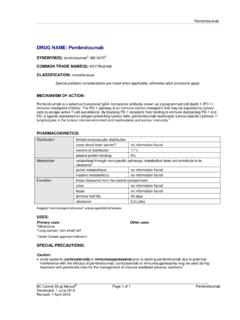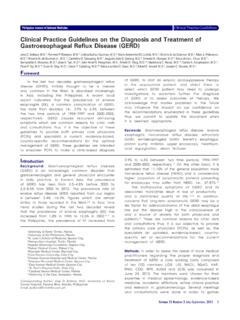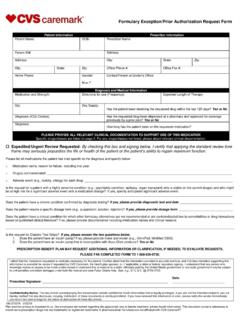Transcription of Chronic Cough: Evaluation and Management
1 November 1, 2017 Volume 96, Number 9 American Family Physician 575 Although Chronic cough in adults ( cough lasting longer than eight weeks) can be caused by many etiologies, four conditions account for most cases: upper airway cough syndrome, gastroesophageal reflux disease/laryngopharyn-geal reflux disease, asthma, and nonasthmatic eosinophilic bronchitis. Patients should be evaluated clinically (with spirometry, if indicated), and empiric treatment should be initi-ated. Other potential causes include angiotensin-converting enzyme inhibitor use, environmental triggers, tobacco use, Chronic obstruc-tive pulmonary disease, and obstructive sleep apnea.
2 Chest radiogra-phy can rule out concerning infectious, inflammatory, and malignant thoracic conditions. Patients with refractory Chronic cough may warrant referral to a pulmonologist or otolaryngologist in addi-tion to a trial of gabapentin, pregabalin, and/or speech therapy. In children, cough is considered Chronic if present for more than four weeks. In children six to 14 years of age, it is most commonly caused by asthma, protracted bacterial bronchitis, and upper airway cough syndrome.
3 Evaluation should focus initially on these etiologies, with targeted treatment and monitoring for resolution. (Am Fam Physi-cian. 2017; 96 (9) :575-580. Copyright 2017 American Academy of Family Physicians.)ILLUSTRATION BY JONATHAN DIMESC hronic cough : Evaluation and ManagementCHARLIE MICHAUDET, MD, and JOHN MALATY, MD, University of Florida College of Medicine, Gainesville, FloridaCough caused by the common cold typically lasts one to three weeks and is self-limited. However, per-sistent Chronic cough can be the first sign of a more serious disease process.
4 According to the Centers for Disease Control and Prevention, cough of undifferentiated duration is the most common presenting symptom in patients of all ages in the primary care ambulatory In adults, Chronic cough is defined as symptoms lasting longer than eight weeks, whereas acute cough lasts less than three weeks and subacute cough from three to eight When persistent and excessive, cough can seriously impair quality of life and lead to vomiting, muscle pain, rib fractures, urinary incontinence, tiredness, syncope, and depression.
5 It also has psychosocial effects, such as embarrassment and negative impact on social This article presents a systematic approach to the Evaluation of Chronic cough , derived from the results of prospective studies and an evidence-based practice ,5 Assessment of Chronic CoughThe initial Evaluation should focus on iden-tifying potential triggers, such as the use of an angiotensin-converting enzyme (ACE) inhibitor, environmental exposures, smok-ing status, and Chronic obstructive pulmo-nary disease (COPD).
6 It should also rule out red flags ( , fever, weight loss, hemoptysis, hoarseness, excessive dyspnea or sputum production, recurrent pneumonia, smok-ing history of 20 pack-years, or smoker older than 45 years) that suggest a serious underly-ing cause of The patient s description of the cough (character, timing, presence or CME This clinical content conforms to AAFP criteria for continuing medical education (CME). See CME Quiz on page 567. Author disclosure: No rel-evant financial affiliations. Patient information: A handout on this topic is available at PRACTICES IN PULMONARY MEDICINE: RECOMMENDATIONS FROM THE CHOOSING WISELY CAMPAIGNR ecommendationSponsoring organizationDo not diagnose or manage asthma without Academy of Allergy, Asthma and ImmunologyCough and cold medicines should not be prescribed or recommended for respiratory illnesses in children younger than four Academy of PediatricsSource.)
7 For more information on the Choosing Wisely Campaign, see For supporting citations and to search Choosing Wisely recom-mendations relevant to primary care, see from the American Family Physician website at Copyright 2017 American Academy of Family Physicians. For the private, noncom-mercial use of one individual user of the website. All other rights reserved. Contact for copyright questions and/or permission Cough576 American Family Physician Volume 96, Number 9 November 1, 2017absence of sputum production) should not determine the clinical approach; sequen-tial or concomitant treatment of common causes is still Unless a likely cause is identified, chest radiography should be obtained to rule out most infectious, inflammatory, and malignant thoracic con-ditions.
8 When physical examination find-ings are normal and no red flags are present, routine computed tomography of the chest and sinuses is not necessary, nor is initial The diagnostic approach should focus on detection and treatment of the four most common causes of Chronic cough in adults: upper airway cough syndrome (UACS), asthma, nonasthmatic eosinophilic bron-chitis, and gastroesophageal reflux disease (GERD)/laryngopharyngeal reflux ,5 After Evaluation and empiric Management of these etiologies, less common causes should be considered (Tables 1 7 and 2 8).
9 A suggested primary care approach to the Evaluation of Chronic cough for immunocompetent adults is shown in Figure Causes of Chronic CoughUPPER AIRWAY cough SYNDROME The term UACS, previously referred to as postnasal drip syndrome, was coined in the 2006 American College of Chest Phy-sicians guideline 4 in recognition of the fact that multiple etiologies, including Chronic rhinosinusitis, allergic rhinitis, and SORT: KEY RECOMMENDATIONS FOR PRACTICEC linical recommendationEvidence ratingReferencesIn adults with Chronic cough , initial Evaluation should focus on the most common causes: upper airway cough syndrome, gastroesophageal or laryngopharyngeal reflux disease, asthma, and nonasthmatic eosinophilic bronchitis.
10 Other causes to consider include angiotensin-converting enzyme inhibitor use, environmental triggers, tobacco use, and Chronic obstructive pulmonary , 4-6, 10, 14, 20-22, 24, 26, 30, 35In patients with refractory Chronic cough , referral to a pulmonologist or otolaryngologist should be considered, as well as a trial of gabapentin (Neurontin), pregabalin (Lyrica), or speech , 5, 36, 38-41In children six to 14 years of age with Chronic cough , initial Evaluation should focus on the most common causes: asthma, protracted bacterial bronchitis, and upper airway cough , 6, 42-44A = consistent, good-quality patient-oriented evidence; B = inconsistent or limited-quality patient-oriented evidence; C = consensus, disease-oriented evidence, usual practice, expert opinion, or case series.












